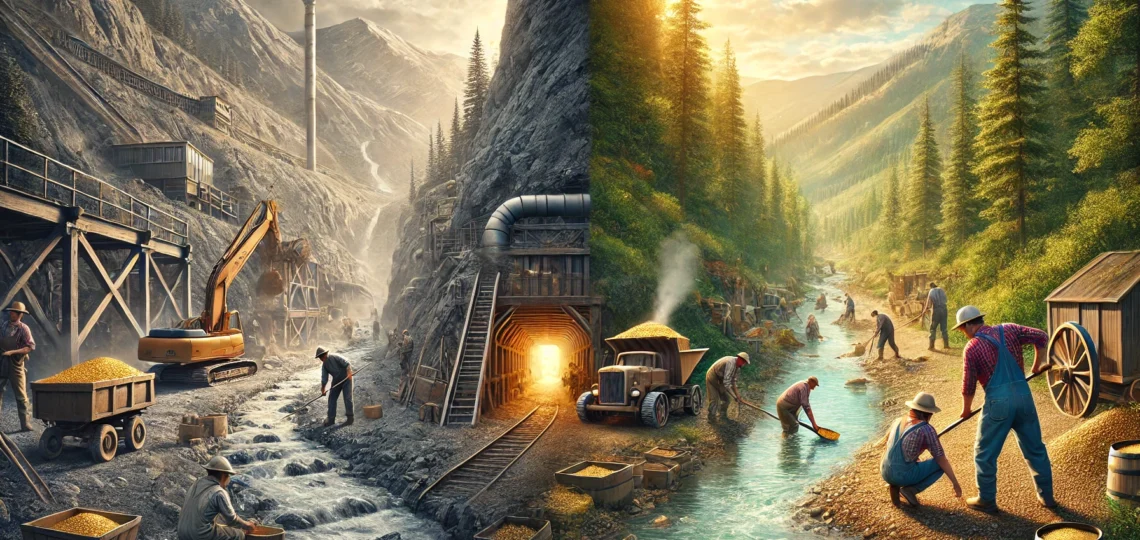
Exploring the Pros and Cons of Hard Rock and Placer Gold Mining
Exploring the Pros and Cons of Hard Rock and Placer Gold Mining

Introduction to Hard Rock and Placer Gold Mining
Gold mining has been a significant part of human history for centuries. From the ancient Egyptians to the California Gold Rush, people have been drawn to the allure of gold and the potential wealth it can bring. There are two main methods of gold mining: hard rock mining and placer mining. Each method has its own advantages and disadvantages, and understanding these can help investors and miners make informed decisions.
Hard rock mining involves extracting gold from hard rock formations, usually through underground mining. This method requires specialized equipment and skilled miners who can navigate the complex underground tunnels. On the other hand, placer mining involves extracting gold from loose sediments, such as riverbeds or beach sands. This method is less labor-intensive and can be done using simple tools like pans and sluice boxes.
Advantages of Hard Rock Gold Mining
One of the main advantages of hard rock mining is the potential for high-grade ore deposits. Hard rock deposits often contain more gold compared to placer deposits, making it a more lucrative option for miners. Additionally, hard rock mining allows for the extraction of other valuable minerals alongside gold, such as silver, copper, and zinc. This diversification can increase the overall profitability of a mining operation.
Furthermore, hard rock mining has a longer lifespan compared to placer mining. Once a hard rock deposit is discovered, it can be mined for many years, providing a stable source of income. This longevity allows for long-term planning and investment in infrastructure, such as underground tunnels and processing facilities.
Disadvantages of Hard Rock Gold Mining
Despite its advantages, hard rock mining also has its drawbacks. One major disadvantage is the high cost associated with this method. Hard rock mining requires significant capital investment in equipment, machinery, and infrastructure. Additionally, the extraction process can be complex and time-consuming, requiring skilled labor and specialized knowledge.
Another disadvantage is the environmental impact of hard rock mining. The extraction of gold from underground can result in the release of harmful chemicals and pollutants into the surrounding environment. These pollutants can contaminate water sources, damage ecosystems, and harm wildlife. Minimizing and mitigating these environmental impacts is a crucial challenge for hard rock mining operations.
Pros and Cons of Placer Gold Mining
Placer gold mining, while less lucrative compared to hard rock mining, has its own set of advantages and disadvantages. One of the main advantages of placer mining is its simplicity. It requires minimal equipment and can be done by individuals or small groups. This accessibility makes placer mining an attractive option for small-scale miners or hobbyists.
Additionally, placer mining has a lower environmental impact compared to hard rock mining. Since it involves extracting gold from loose sediments, there is no need for extensive excavation or underground tunnels. This reduces the disturbance to the natural landscape and minimizes the release of harmful pollutants.
However, placer mining also has its limitations. The main disadvantage is the lower potential for high-grade gold deposits. Placer deposits tend to have lower gold concentrations compared to hard rock deposits, resulting in lower overall yields. This can make it challenging for placer miners to achieve significant profits, especially when operating on a larger scale.
Furthermore, placer mining is highly dependent on natural factors such as water availability and sediment deposition. Changes in river patterns or climate conditions can significantly impact the viability of placer mining operations. This unpredictability can make it difficult for miners to plan and sustain their operations in the long term.
In conclusion, both hard rock and placer gold mining have their own set of advantages and disadvantages. Hard rock mining offers the potential for high-grade ore deposits and long-term profitability but comes with high costs and environmental challenges. Placer mining, on the other hand, is simpler and has a lower environmental impact but may yield lower overall profits and is subject to natural variability. Understanding these pros and cons is crucial for miners and investors to make informed decisions and ensure sustainable and responsible mining practices.

